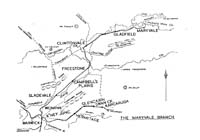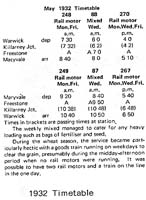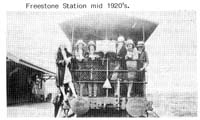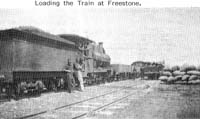- known as the ‘VIA RECTA’ (right way) line to Warwick.
Trial surveys for this line began as early as 1880. In 1884 some five alternative routes were presented to the Government. It was March 18th 1910, before the first sod was turned by the then Premier of Queensland, Mr William Kidston. The people of Warwick presented Mr Kidston with a silver spade, suitably engraved, to mark the occasion. The spade is still in the possession of his niece, Miss Jean Palmer, a former well known Freestone resident, now living in Warwick.
the branch line was to be 18 miles 67 chains from Warwick to Maryvale, leaving the Killarney Junction to travel through Campbell’s Plains, Freestone, Clintonvale, Gladfield and Maryvale.
There were few delays in the construction and the opening was held on 30th September 1911. A large crowd of over 4000, many travelling free of charge on three separate trains from Warwick, greeted the Premier, the Hon D F Denham, and the minister for railways the Hon W T Paget at Maryvale. Shortly after 2pm, the Premier and Mr Paget boarded the footplate of the engine, and declaring the line open, put the engine through a band of blue ribbon held by two "wee girlies". At last, after nearly 30 years, the first stage of the ‘via Recta’ was opened.
The railway paved the way for the settlement of the township, and during 1911, blocks of land at Freestone township were auctioned for around 29 pounds per block.
(This is how the Freestone Railway Station looked).
Before the railway line arrived, farmers had to cart their grain by dray and wagon to Swan Creek station, or other stations on the Killarney line, for shipment to Warwick. Cream also had to be carted to Warwick by wagon and mail was brought out from Warwick on horseback. During the boom years around the 1920’s, wagons and drays would be lined up in all directions from the Freestone Station.
(Left - 1932 timetable)
The train would often come out late in the afternoon, leaving the trucks to be loaded with grain and picked up in the morning on the return trip from Maryvale.
Cream and pigs were also transported to Warwick by train, with the pigs sometimes being walked to the railway station - often a difficult job. Lucerne was made into chaff and bagged and taken to the railway station. The main grain crop was wheat with not much barley grown then.
With the increase of road transport, the construction of the road over Cunningham’s Gap, and the decision not to continue the construction of the rail link over the range to join the Mt Edwards/Fassifern branch to Ipswich, the need for the rail service began to decline.
It was ‘closed to traffic on or after 1st November 1960, because it had become an uneconomical operation’, as reported by the Commissioner for Railways in his June 1961 report. The tracks were dismantled shortly after, and the railway had become a memory.
ref. Queensland Government Railways Historical Section.
1. (Freestone Station mid 1920’s).
2. (Loading the train at Freestone)
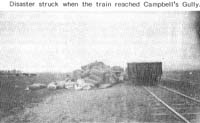 3. (Disaster struck when the train reached Campbell’s Gully)
3. (Disaster struck when the train reached Campbell’s Gully)
